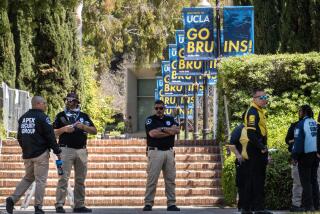The Strikers, the Mine and the Men in the Middle : Labor: Since the coal workers walked out in May, security guards are trying to hold an elusive line on Scab Alley.
- Share via
PERCY, Ill. — “Scab Alley” marks the demilitarized zone.
The dusty gravel road, christened by union officials, winds through prairie and pine forest, past miners’ shacks and campfires, ending at a gate of the Arch of Illinois mining complex.
On one side are hundreds of striking coal miners. On the other are the security guards hired to keep them away.
For the guards behind the gate, standing watch over Scab Alley is a job that puts them on war alert every night.
Guards in black uniforms use night-vision sniper scopes to spy on the alley and stretches of prairie. A quick-reaction force stands ready near its trucks to repel any incursion. Nightfall brings a surreal fight against shadows that float out of the darkness, wreak havoc, then disappear.
“Every night, there’s something,” whispered Dick Flanagan, an ex-Navy commando, as he scanned the horizon one evening with a night-vision scope. “When the lights go out, crazy things start to happen.”
Each side in the 6-month-old United Mine Workers strike blames the other for the crazy things: dozens of incidents of vandalism and violence, sabotage of the mine power system, shots fired at guards.
Flanagan and his guards are the men in the middle.
They were hired by Arch in May from a Marietta, Ohio, security company to protect 30 square miles of company property around two mines near Percy.
It’s an odd life of boring days and fearful nights. The guards, most of them ex-military, sign on for tours of 60 days. They are not allowed to leave the property or drink alcohol. They sleep in an office building.
Unarmed except for flashlights, radios and video cameras, they aren’t allowed to detain anyone. Their orders are to “observe, document and report,” said site supervisor Dave Williams.
Some can’t hack it.
“Some guys stay a week, two weeks, and then say, ‘Hey, it’s not for me,’ ” Williams said. “We’ve lost about three or four since we’ve been here.”
Others say it’s not bad.
“I’ve been in worse places. This is a piece of cake,” said Luis, an ex-Green Beret from New York City who’s been on the job since October. “We have a job to do. Nobody wins. When we’re working, they’re out of a job. When they (strikers) come back to work, we’ll be out of a job.”
With the exception of Flanagan, the night supervisor--and the son of a coal miner--the other guards asked that their last names not be used. They said they fear miners will seek retribution against their families.
Since the UMW struck selected members of the Bituminous Coal Operators Assn. on May 10 over job security, the strike has expanded to 17,500 miners in seven states.
About 600 miners struck Arch, a subsidiary of St. Louis-based Arch Minerals Corp. The company defied strikers by bringing in 60 temporary miners from Kentucky.
Arch has reported dozens of incidents of vandalism and violence during the strike.
Guards have been shot at and more than 20 power poles sawed or burned at a cost of $5,000 each, said Arch spokesman Blair Gardner. Jack rocks--nails twisted to resemble toy jacks--litter the roads, and it’s hard to find a mine employee who hasn’t had a punctured tire, he said.
Other coal companies are reporting similar incidents.
Arch officials say it is difficult to guard the sprawling complex, most of it unfenced. “I could take another 100 security guards and never cover all of it,” said human resources director Hugh Place.
UMW representatives deny coal industry allegations that the union has organized terrorism against the mines. The UMW has suggested the vandalism may be caused by non-union hooligans or even by coal company workers themselves.
“For me to fathom sneaking onto their property, it would be really tough. They guard it pretty well,” said Rick Shawgo, vice president of UMW Local 1392, which represents the Arch miners.
Thanks in part to the guards, Arch productivity is at 40% of pre-strike levels with a quarter of the work force, Gardner said.
Arch pays Southeastern Security and Investigations $100,000 a week, Place said. None of the guards would say what they are paid, but some said money drew them to the job.
“I don’t mind this line of work. It’s pretty interesting. But it’s the money,” said Joey, a 27-year-old guard from Ohio, who said someone in a pickup took a shot at him while he was checking a water pump.
The camaraderie and bravado of the guards is apparent during a late-night tour of their posts.
On this evening, Flanagan and Rick, a 27-year-old Ohioan saving money to finish his engineering degree, were chatting on a catwalk over the compound’s 4 1/2-mile belt line, which moves coal from the mine to a preparation plant.
As they exchanged jokes, the hiss of a walkie-talkie was broken by a sentry’s screams for help along a section of belt line damaged earlier.
“I see two of them! They’re coming towards me! Get someone over here quick!” the voice shouted.
Flanagan ran down 50 feet of stairs and tore off in his truck at 100 m.p.h., stirring up clouds of dust that blocked the road. Within minutes, he was where the figures were seen, a well-lighted section of conveyor surrounded by pines and rolling hills.
No one was found. But that didn’t surprise anyone, and the night shift went on.
“You got to be different to like this job,” Joey said. “This isn’t for the average human being. You got to be a little off the wall.”
More to Read
Sign up for Essential California
The most important California stories and recommendations in your inbox every morning.
You may occasionally receive promotional content from the Los Angeles Times.













